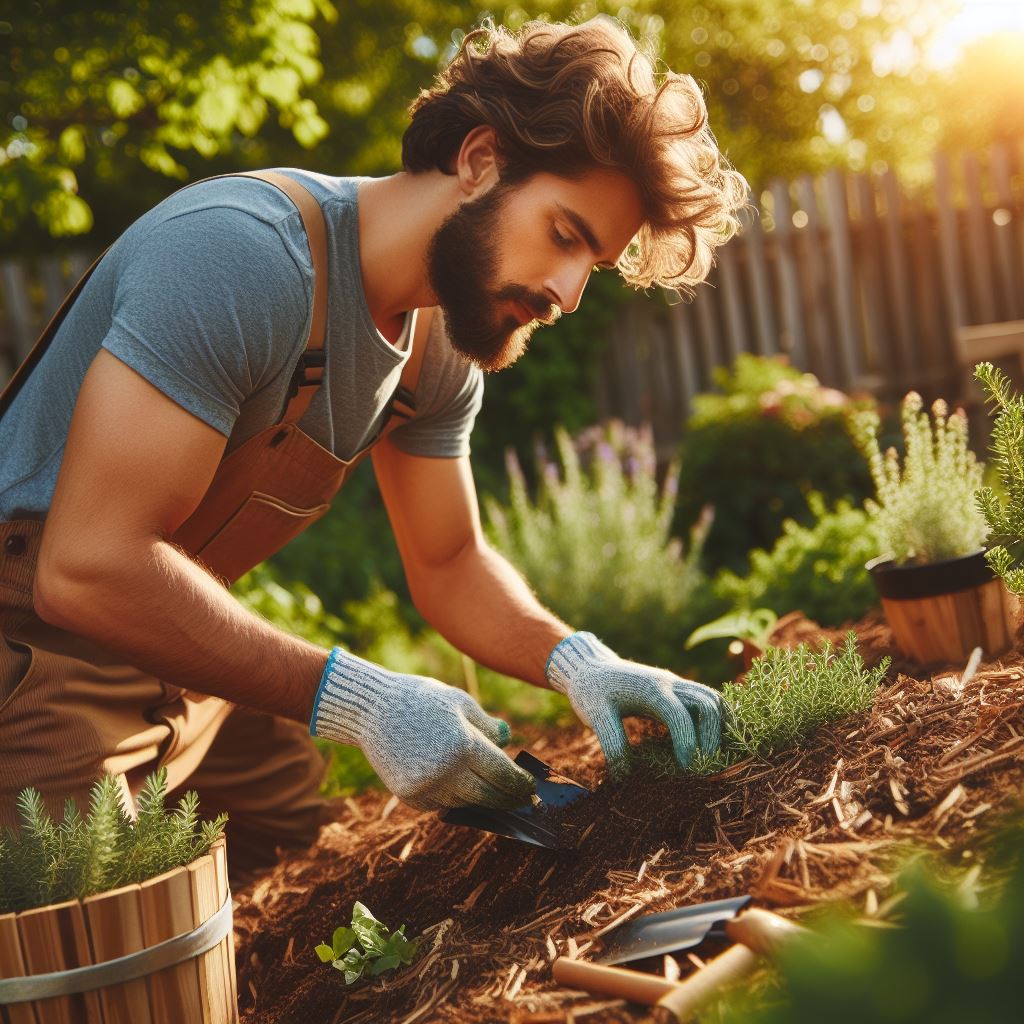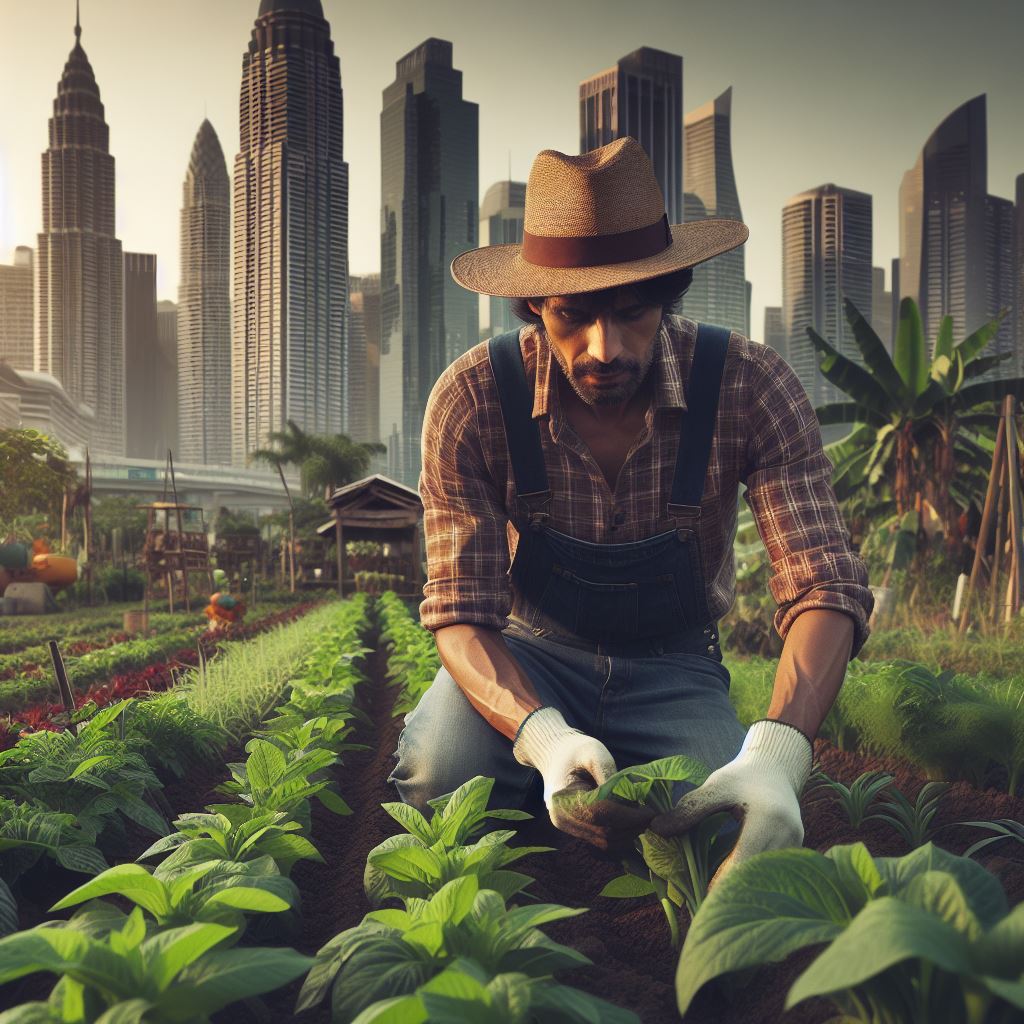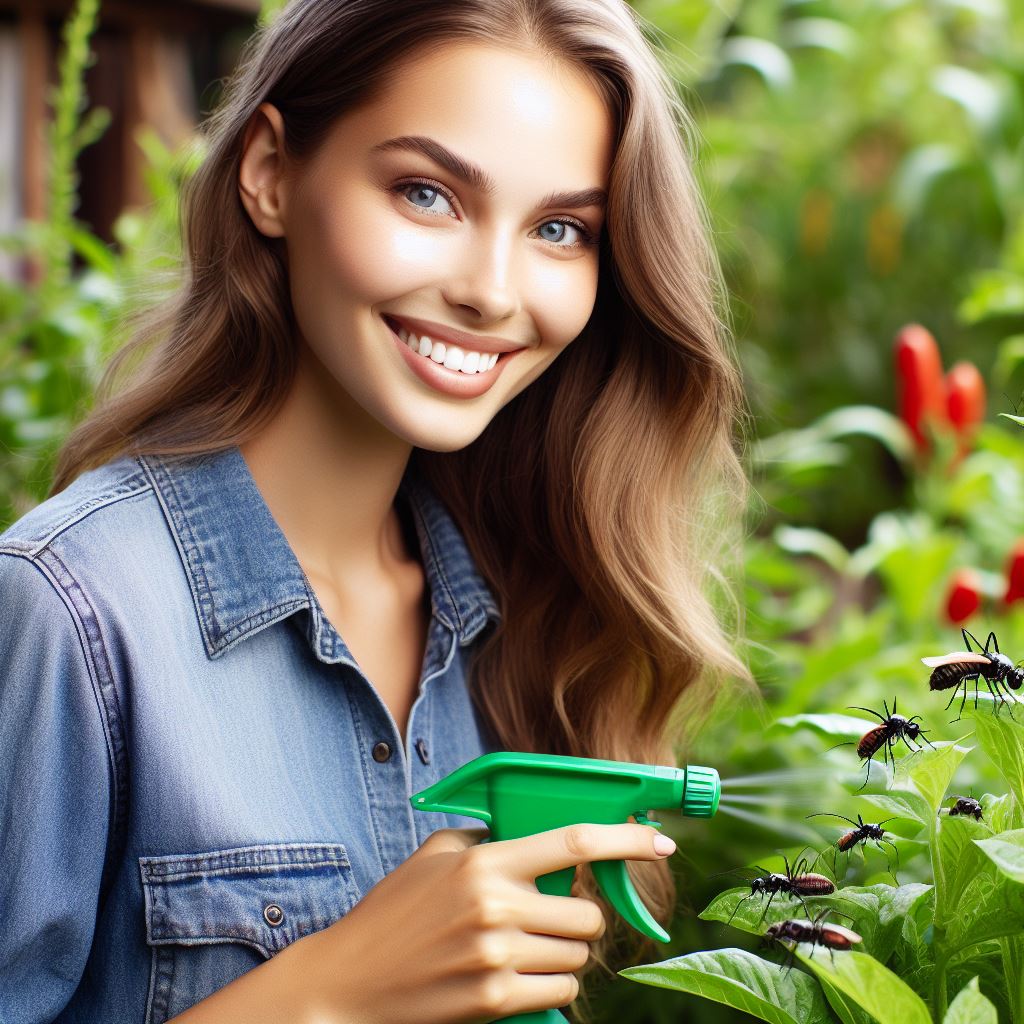Introduction
Garden mulching is the process of covering the soil with a layer of organic material.
The purpose of mulching is to conserve moisture, suppress weeds, and improve soil health.
Garden mulching is an effective way to reduce water use in gardening.
It plays a crucial role in sustainable gardening practices and water conservation efforts.
By implementing mulching techniques, gardeners can promote plant growth while minimizing water consumption.
Mulching can be done using different materials like compost, wood chips, straw, or shredded leaves.
The material used for mulching helps in retaining moisture in the soil, reducing the need for frequent watering.
Mulching also acts as a barrier, preventing evaporation and keeping the soil temperature stable.
In addition to water conservation, mulching prevents weed growth, which competes for resources with garden plants.
The layer of mulch blocks sunlight, hindering weed germination and reducing the need for herbicides.
Moreover, mulching provides insulation to the soil, protecting it from extreme temperatures and erosion.
The organic matter added through mulching enriches the soil, enhancing its fertility and nutrient content.
Garden mulching is a cost-effective and environmentally friendly practice that helps in reducing water use efficiently.
Benefits of garden mulching in reducing water use
A well-maintained garden requires proper watering to ensure the growth and health of plants.
However, water scarcity is becoming a global concern, making efficient water usage essential.
Transform Your Agribusiness
Unlock your farm's potential with expert advice tailored to your needs. Get actionable steps that drive real results.
Get StartedGarden mulching is a simple yet effective technique that can significantly reduce water consumption.
Let’s explore the various benefits of using mulch in your garden:
Retains moisture in the soil
- Mulching helps to retain moisture in the soil by acting as a protective barrier.
- The layer of mulch prevents water from evaporating quickly, keeping the soil moist for longer periods.
- This moisture retention reduces the need for frequent watering, saving both time and water resources.
Reduces evaporation
- Another advantage of garden mulching is the prevention of water evaporation from the soil surface.
- The mulch layer shields the soil from direct sunlight, which can quickly dry it out.
- By reducing evaporation, mulching ensures that more water is available for plant absorption.
Suppresses weed growth
- Weeds compete with garden plants for water, nutrients, and sunlight.
- Mulching acts as a natural weed suppressant by blocking the sunlight that seeds need to germinate and grow.
- The mulch layer also creates a barrier against weed emergence from the soil, reducing the need for manual weeding.
Regulates soil temperature
- Mulch helps to regulate soil temperature, protecting plants from extreme heat or cold.
- During hot weather, mulch acts as insulation, preventing the soil from overheating.
- In colder climates, mulch provides a protective layer, keeping the soil warmer and facilitating root growth.
In addition to reducing water use, garden mulching offers other benefits such as improving soil fertility, preventing erosion, and enhancing the overall aesthetics of your garden.
However, it’s essential to choose the right mulch material and apply it correctly for optimal results.
Organic mulches like wood chips, straw, or shredded leaves are excellent choices as they break down over time, adding organic matter to the soil.
These mulches also create a favorable environment for beneficial soil organisms.
When mulching, ensure that you spread the material evenly around plants, leaving space around the stem to prevent rotting.
The mulch layer should be around 2-4 inches thick to provide adequate coverage and insulation.
By practicing garden mulching, you can significantly reduce water use while maintaining a healthy and thriving garden.
Mulching not only conserves water but also promotes sustainable gardening practices.
Why not give it a try and enjoy the multitude of benefits mulching has to offer?
Read: Container Gardening: Water-Smart Techniques
Types of garden mulch materials
Garden mulching is a cost-effective and efficient way to reduce water usage.
By adding a layer of mulch to your garden beds, you can save water, control weeds, and improve the overall health of your plants.
In this section, we will discuss different types of garden mulch materials available for you to choose from.
There are two main categories: organic mulch materials and inorganic mulch materials.
Organic Mulch Materials
- Shredded leaves: Shredded leaves are a great option for garden mulch. They provide a natural look, improve soil quality, and suppress weed growth. Plus, they are free if you have trees in your yard.
- Grass clippings: If you mow your lawn regularly, don’t throw away the grass clippings! They can be used as mulch. Grass clippings help retain moisture and provide nutrients to the soil as they decompose.
- Straw or hay: Straw and hay are commonly used as mulch materials. They are easy to find and relatively inexpensive. Straw or hay mulch helps regulate soil temperature, prevent erosion, and control weed growth.
- Wood chips or bark: Wood chips and bark are popular choices for garden mulching. They provide a natural aesthetic appeal, improve soil structure, and retain moisture. However, they may take longer to decompose than other organic mulch materials.
Inorganic Mulch Materials
- Gravel or pebbles: Gravel or pebbles are excellent options for inorganic mulch. They can withstand heavy rainfall, enhance drainage, and give a decorative touch to your garden.
They don’t improve soil fertility like organic mulch materials. - Plastic sheeting: Plastic sheeting is a practical choice for weed control and moisture retention. It creates a barrier that blocks sunlight and prevents weed growth.
It may not be the most visually appealing option for some gardeners. - Rubber mulch: Rubber mulch is made from recycled tires and provides excellent weed suppression. It also retains moisture and doesn’t decompose like organic mulch materials.
It may release certain chemicals into the soil over time.
Factors to consider when choosing your mulch material
When choosing the type of mulch material for your garden, consider factors such as cost, availability, aesthetics, and the specific needs of your plants.
Organic mulch materials are more environmentally friendly and can improve soil fertility, while inorganic mulch materials offer longer-lasting solutions and can be visually appealing.
Remember, regardless of the type of mulch you choose, always apply it in a layer of 2-4 inches thick.
This will help conserve soil moisture, reduce weed growth, and create an optimal growing environment for your plants.
In general, garden mulching is an effective way to reduce water use in your garden.
By selecting the right mulch materials, you can achieve water conservation, weed control, and healthier plants.
Consider the various options available and choose the best mulch for your specific needs and preferences.
Read: Urban Green Thumbs: Saving Water in Style
Showcase Your Farming Business
Publish your professional farming services profile on our blog for a one-time fee of $200 and reach a dedicated audience of farmers and agribusiness owners.
Publish Your ProfileChoosing the right garden mulch for your plants
Consideration of plant type and needs
When selecting a garden mulch, it is important to first consider the type of plants in your garden.
Different plants have different needs when it comes to mulching.
- Flowering plants: Flowering plants benefit from organic mulches such as compost or shredded leaves. These mulches provide nutrients to the soil and help retain moisture, promoting healthy blooms.
- Vegetable plants: Vegetable plants thrive with mulches like straw or hay. These materials help prevent weed growth, retain soil moisture, and regulate soil temperature.
- Evergreen plants: Evergreen plants, such as pine trees, prefer mulches like pine needles or wood chips. These mulches help maintain soil acidity and prevent weed growth.
Climate and weather conditions
Another important factor to consider when choosing garden mulch is the climate and weather conditions in your area.
Different mulches work better in certain climates.
- Hot and dry climates: In hot and dry climates, it is best to choose mulches that help retain moisture in the soil. Mulches like wood chips or straw are excellent choices as they prevent water evaporation and protect plants from extreme heat.
- Cold climates: In colder climates, mulches that provide insulation are key. Mulches like straw, hay, or pine needles help regulate soil temperature and protect plant roots from freezing.
- Wet climates: In wet climates, mulches that allow for good drainage are necessary to avoid waterlogging. Mulches made of pebbles or gravel are ideal as they allow excess water to flow through easily.
Availability and cost of mulch materials
The availability and cost of mulch materials should be taken into account.
Consider what materials are readily accessible in your area and how much you are willing to spend.
- Organic mulches: Organic mulches like compost, straw, or shredded leaves are usually more readily available and affordable. They can often be sourced from your own garden or local suppliers.
- Inorganic mulches: Inorganic mulches like rubber or plastic mulch may be more expensive and less common. However, they offer long-lasting benefits and are effective in controlling weeds and conserving moisture.
- Mulch alternatives: If traditional mulch materials are not easily accessible or within your budget, there are alternative options. Grass clippings, newspaper, or cardboard can all be used as makeshift mulches.
In essence, when choosing the right garden mulch for your plants, consider the specific needs of your plants, the climate and weather conditions in your area, and the availability and cost of mulch materials.
By selecting the appropriate mulch, you can effectively reduce water use and ensure the health and vitality of your garden.
Read: Gardening in Drought: Tips for Water Economy

Proper application of garden mulch
In order to effectively reduce water use in your garden, proper application of garden mulch is essential.
Here are some important steps to consider:
Preparing the soil before mulching
Properly preparing the soil before mulching is crucial for the overall success of your garden.
Clearing away any existing weeds and debris will help prevent them from competing with your plants for water and nutrients.
Leveling the soil surface ensures a uniform distribution of mulch, allowing it to perform its water conservation role more effectively.
Applying the mulch correctly
1. Spreading a layer evenly around plants
When it comes to applying the mulch, there are a few key considerations to keep in mind.
First, make sure to spread the mulch layer evenly around your plants, covering the entire root zone.
This helps to retain moisture by reducing evaporation and suppressing weed growth.
2. Avoiding piling mulch against stems or trunks
In addition, it’s important to avoid piling the mulch directly against the stems or trunks of your plants.
This can create a moist environment that is conducive to rot and the development of pests and diseases.
Leave a small gap around the base of each plant to allow for proper air circulation.
3. Mulch thickness recommendations
Follow the recommended guidelines for mulch thickness.
The ideal thickness will depend on the type of mulch you are using and the specific needs of your plants.
A layer that is too thin may not provide adequate protection against evaporation, while a layer that is too thick can hinder water penetration and prevent oxygen from reaching the roots.
By taking the time to properly apply garden mulch, you can significantly reduce water use in your garden.
The mulch acts as a barrier, helping to retain moisture in the soil and reducing the need for frequent watering.
It also helps to regulate soil temperatures and suppress weed growth, further improving the overall health and vitality of your plants.
Remember, mulching is not a one-time task.
It’s important to regularly monitor the condition of your mulch and replenish it as needed.
Over time, the mulch will break down and decompose, becoming part of the soil and enriching it with organic matter.
By following these guidelines, you can enjoy a beautiful and water-efficient garden.
Read: Drip Irrigation: Small Farm Water-Saving Guide
Maintaining garden mulch and maximizing water saving
A well-maintained garden mulch not only enhances the aesthetics of your garden but also helps conserve water.
By monitoring soil moisture levels, mulch maintenance, and effective watering techniques, you can ensure maximum water savings.
Monitoring soil moisture levels
Regularly checking soil moisture levels is crucial in maintaining a healthy garden.
This will help you determine if your plants are receiving adequate water or if they need additional irrigation.
Mulch maintenance and replenishment
Mulch can break down over time, so it is important to regularly inspect and replenish it.
Aim for a mulch depth of 2-4 inches to prevent evaporation and weed growth.
Effective watering techniques
Implementing proper watering techniques can make a significant difference in water conservation.
1. Deep watering
Instead of shallow watering, which encourages shallow root growth, deep watering allows the roots to grow deeper into the soil.
This results in better water absorption and less evaporation.
Showcase Your Farming Business
Publish your professional farming services profile on our blog for a one-time fee of $200 and reach a dedicated audience of farmers and agribusiness owners.
Publish Your Profile2. Watering at appropriate times of day
Watering early in the morning or late in the evening when temperatures are cooler reduces water loss to evaporation.
Avoid watering during the hottest part of the day to prevent water waste.
3. Use of irrigation systems
Installing an irrigation system, such as drip irrigation or soaker hoses, can be an efficient way to water your garden.
These systems deliver water directly to the roots, minimizing wastage.
Maintaining garden mulch and practicing effective water-saving techniques can lead to significant water conservation and a healthier garden environment.
Common mistakes and troubleshooting
Over-mulching and oxygen deprivation to roots
- Applying excessive mulch can suffocate plant roots by restricting oxygen flow.
- Avoid piling mulch too high against the base of plants to prevent root rot.
- Maintain a proper mulch thickness of 2 to 4 inches to allow air circulation.
- Spread the mulch evenly around plants, keeping the mulch away from the stem.
- Check for signs of oxygen deprivation, such as yellowing leaves or stunted growth.
Weed breakthrough issues
- Insufficient mulch depth can lead to weed breakthroughs and competition for resources.
- Ensure a thick layer of mulch, as weeds require sunlight to germinate and grow.
- Regularly inspect the mulch layer and add more when it begins to thin out.
- Pull out any weeds that manage to break through the mulch to prevent spreading.
- Use organic weed control methods, such as manual removal or mulch-compatible herbicides.
Pest problems associated with particular mulch types
- Certain mulch types can harbor pests, leading to infestations in the garden.
- Avoid using fresh wood chips or bark mulch, as they attract termites and other insects.
- Be cautious when using straw or hay mulch, as they may contain weed seeds or pests.
- Consider using mulch made from cocoa shells, as it deters snails and slugs.
- Regularly inspect the garden for signs of pest activity and take appropriate preventive measures.
While garden mulching is an effective method to reduce water use, it is essential to avoid common mistakes that can hinder its benefits.
Over-mulching can suffocate plant roots, causing oxygen deprivation. Weed breakthrough issues can be prevented by maintaining a sufficient mulch layer.
Certain mulch types may attract pests, affecting the overall health of the garden.
By being aware of these mistakes and taking necessary troubleshooting steps, gardeners can optimize the effectiveness of mulching and promote a thriving and water-efficient garden.
Conclusion
Recap of the benefits and importance
Garden mulching is an effective method to reduce water usage in gardening.
It helps to retain moisture, suppress weeds, and regulate soil temperature.
These benefits contribute to healthier plants, increased crop yield, and reduced water bills.
Encouragement to incorporate garden mulching for sustainable gardening practices
If you want to conserve water in your garden and promote sustainability, incorporating mulching should be a priority.
By implementing this practice, you are taking a step towards a healthier environment and becoming a responsible gardener.
Final tips for successful water-saving garden mulching
- Choose the right type of mulch – organic materials like straw, wood chips, or shredded leaves work well.
- Apply mulch properly – spread it evenly around plants, ensuring a depth of 2-4 inches.
- Maintain mulch regularly – replenish mulch as needed to maintain the desired depth.
- Water plants properly – avoid overwatering by adjusting watering frequency based on the moisture levels observed beneath the mulch layer.
- Control weed growth – prevent weed seeds from germinating by using a weed barrier beneath the mulch or applying a layer of cardboard or newspaper.
In a nutshell, garden mulching is a simple yet effective technique for conserving water in gardening.
By implementing it properly and following the guidelines provided, you can create a sustainable garden that thrives while reducing your water consumption.




